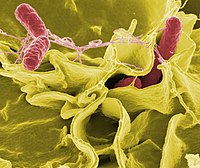
Photo from wikipedia
OBJECTIVES This study investigated the occurrence of extended-spectrum beta-lactamase (ESBL)-producing Salmonella and the associated virulence genes among farmed chickens. METHODS Cloacal swab samples were collected from apparently healthy and diseased… Click to show full abstract
OBJECTIVES This study investigated the occurrence of extended-spectrum beta-lactamase (ESBL)-producing Salmonella and the associated virulence genes among farmed chickens. METHODS Cloacal swab samples were collected from apparently healthy and diseased chickens and were cultured for Salmonella using conventional methods. The isolates were serotyped using slide agglutination tests and were examined by PCR for the virulence genes invA, stn, svpC, and pefA, as well as the outer membrane protein-encoding genes ompA and ompF. Screening for ESBL resistance was performed using disk-diffusion test, combinational-disk test with clavulanic acid, and multiplex PCR for blaTEM, blaSHV, blaCTX-M, and blaOXA. The presence of the AmpC blaCMy-2 was tested among the ESBL-negative isolates by uniplex PCR. The resistant isolates were partially sequenced based on stn gene. RESULTS The Salmonella isolation rate was 3.4% (6 / 175) from healthy and 11.1% (14 / 126) from diseased chickens. The 20 isolates belong to serotypes with public health significance like Typhimurium, Kentucky, and Infantis. All the isolates possess invA, stn, svpC, and ompF genes; 16 isolates harbored ompA, and one carried pefA. Of the 20 isolates, 19 were resistant to more than one antibiotic. Of these 19 isolates, 16 were ESBL-producing with majority carry blaTEM and blaSHV genes. The 4 ESBL-negative isolates carried blaCMy-2. Partial-stn-sequencing of the isolates revealed a high genetic relatedness to Salmonella strains from patients in Egypt and Asia. CONCLUSIONS Virulent ESBL-producing Salmonella was isolated from healthy and diseased chickens, the strains have close relation to human strains, posing a public health threat.
Journal Title: Journal of global antimicrobial resistance
Year Published: 2020
Link to full text (if available)
Share on Social Media: Sign Up to like & get
recommendations!